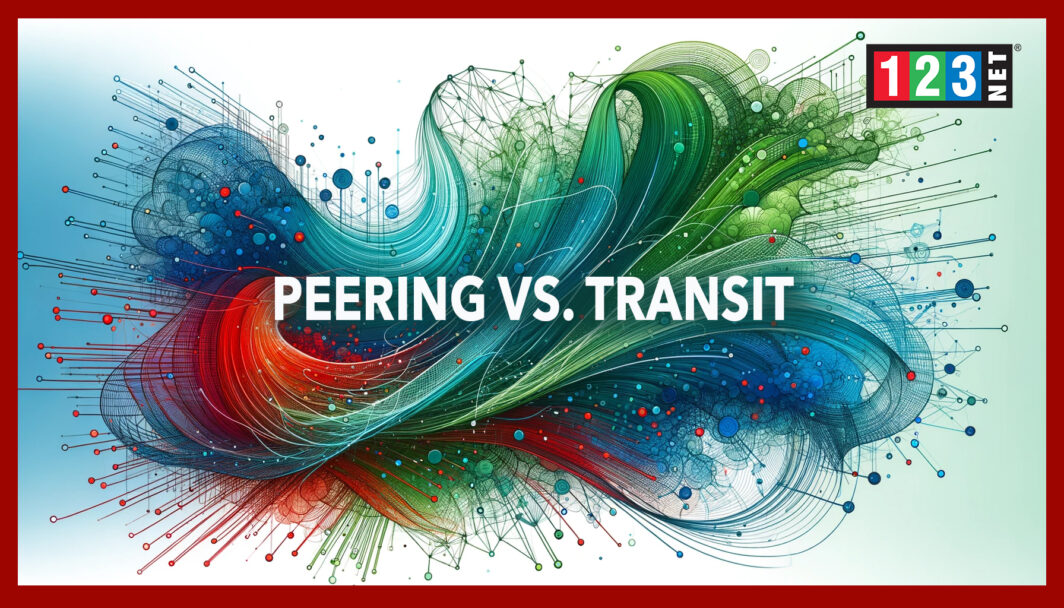
Introduction to Peering vs Transit
In the realm of internet connectivity, two pivotal concepts, peering vs transit, play a crucial role in shaping the global network landscape. These mechanisms are essential in facilitating the exchange of data across the internet’s vast network, serving as the backbone of our digital world. Internet Service Providers (ISPs) and Content Delivery Networks (CDNs) employ these strategies to streamline and optimize the flow of information.
Peering is characterized by a reciprocal arrangement between two network entities, wherein they agree to exchange traffic directly. This method of data exchange is beneficial as it can reduce the need for intermediary networks.. It is a common practice among ISPs to establish peering agreements to enhance their network connectivity and service quality.
Transit, in contrast, is more akin to a service provided by ISPs to smaller networks or ISPs. In this arrangement, an ISP grants access to the entire internet, often in exchange for a fee. This service is crucial for smaller networks that require a gateway to the broader internet.
Understanding these concepts is key to comprehending the intricate network of relationships and agreements that enable our seamless access. The subsequent sections will explore the technical, economic, and performance aspects of these methods.
Historical Evolution of Internet Connectivity
This transformation has been largely fueled by the rise of Internet Exchange Points (IXPs), encompassing Internet Service Providers (ISPs) and Content Delivery Networks (CDNs). IXPs have played a critical role in dismantling the traditional tiered system that was heavily dependent. Instead, they have fostered a more democratized and interconnected network framework. This fundamental change in the internet’s architecture has not only diversified the paths through which data travels. Understanding this historical transition is essential to grasp the complexities and current dynamics of peering and transit.
Economic Aspects of Peering vs Transit
The economic implications of peering vs transit are substantial, especially for Internet Service Providers (ISPs) and Content Delivery Networks (CDNs). Peering, a mutually beneficial arrangement between ISPs, significantly reduces the costs associated with upstream transit. This cost-efficiency stems from the ability of ISPs to exchange traffic directly with each other. Such arrangements are not only cost-effective but also contribute to enhanced network performance.
For CDNs, peering is a strategic approach that enables them to deliver content more efficiently. By establishing peering agreements, CDNs can minimize latency, a crucial factor in user experience, especially for high-bandwidth applications like video streaming and large-scale data transfers. This efficient distribution of content is pivotal in maintaining the quality of service and user satisfaction.
Conversely, transit agreements, often involving a fee, are indispensable for ISPs to access parts of the internet that are beyond the reach of their peering networks. While these agreements can be more expensive than peering, they are crucial for comprehensive internet access, especially for smaller ISPs or those in regions with limited peering opportunities.
Performance Analysis: Peering vs Transit
Performance is a fundamental aspect distinguishing peering vs transit in the realm of internet connectivity. Extensive studies and empirical evidence suggest that peering typically offers superior network performance compared to transit, owing to several key factors. The primary advantages of peering in terms of performance are attributed to reduced propagation and queuing delays.
Propagation delay, the duration required for a data packet to travel from its source to the destination, is considerably less in peering scenarios. This efficiency is due to the shorter and more direct paths that data packets travel when ISPs exchange traffic directly. Unlike transit, where data might pass through multiple intermediary networks, thus lengthening the journey, peering streamlines this path, resulting in faster data transmission.
Queuing delay, another critical performance metric, is also significantly mitigated in peering arrangements. This delay occurs at network nodes, especially when they are congested with high volumes of traffic. In transit setups, where data often passes through various networks and nodes, the likelihood of encountering such congestion is higher. Peering, by facilitating direct data exchange between networks, often bypasses these congested transit nodes. This results in smoother, more efficient traffic flow, enhancing overall network performance
Technical Challenges in Performance Comparison
Comparing the performance of peering and transit in internet connectivity involves navigating a range of technical complexities. One of the primary challenges lies in accurately measuring key network performance metrics, such as the TCP Congestion Window, Application Layer Latency, and overall network throughput. These metrics are essential indicators of network efficiency and reliability, making their precise evaluation critical for a valid comparison between peering and transit.
The TCP Congestion Window, for instance, plays a crucial role in determining how much data can be sent over the network before requiring an acknowledgment. Its size directly impacts network throughput and efficiency. Application Layer Latency, another critical metric, refers to the delay experienced by data as it moves through the application layer of the network stack, influencing the user experience directly.
Moreover, conducting these measurements under varying network conditions is vital for a comprehensive comparison. Network performance can vary significantly under different loads and traffic patterns, making it essential to test in diverse scenarios to gain a holistic understanding of each method’s performance.
The geographically distributed nature of networks further complicates this analysis. Networks span across various regions, each with its own infrastructure and traffic dynamics. This geographical diversity means that performance can vary greatly from one location to another, making it challenging to generalize findings.
This section will explore the methodologies used to navigate these challenges, offering insights into how performance comparisons are conducted in real-world scenarios. It will discuss the tools and techniques used to measure these metrics accurately and how different network conditions and geographical factors are accounted for in the analysis. By understanding these methodologies and challenges, we can gain a clearer picture of the nuances involved in evaluating the performance of peering versus transit in global internet connectivity.
Case Studies and Real-World Examples of Peering & Transit
To effectively demonstrate the real-world implications of peering and transit in internet connectivity, this section delves into a series of case studies involving Internet Service Providers (ISPs) and Content Delivery Networks (CDNs). These studies highlight the diverse network interconnection strategies adopted by different entities and how these strategies influence traffic dynamics, the functionality of Autonomous Systems (ASes), and ultimately, the end-user experience.
ISP
One case study may focus on a major ISP that has extensively invested in peering agreements. The study will explore how this ISP leverages these agreements to manage traffic flow, optimize network performance, and reduce costs. It will detail the ISP’s network architecture, showing how peering points are integrated and how this integration affects data routing and latency. The case study will also assess the impact on the ISP’s customers, particularly in terms of internet speed and reliability.
CDN
Another case study might examine a CDN known for its global reach and high performance. This study will provide insights into how the CDN uses a mix of peering and transit to efficiently deliver content to users worldwide. It will explore the CDN’s strategy in selecting peering partners and transit providers, considering factors like geographical reach, network capacity, and cost. The study will also discuss how the CDN’s network interconnection choices affect content delivery speed, scalability, and user satisfaction.
A different perspective can be offered through a case study on a smaller, regional ISP. This study will illustrate the challenges and benefits of transit in an environment where extensive peering is not feasible. It will detail the ISP’s reliance on transit agreements to access broader internet content and services, discussing how this reliance impacts network performance and customer service.
ASes
These case studies will also shed light on the role of Autonomous Systems (ASes) in managing internet traffic. They will explain how ASes, through their routing policies and interconnection agreements, play a critical role in the overall efficiency of internet connectivity. The section will highlight how ASes make strategic decisions about peering and transit, balancing cost, performance, and network resilience.
Furthermore, the impact of these decisions on end-user experience will be a key focus. The case studies will demonstrate how the choice between peering and transit can affect factors like internet speed, data latency, network reliability, and even the cost of internet services to the end consumer.
Future Trends and Developments of Peering vs Transit
The future trajectory of internet connectivity is poised to be significantly influenced by continual technological advancements and the evolving landscape of network demands. This section will delve into prospective trends in peering and transit, taking into account several pivotal factors shaping this evolution.
One major driving force is the escalating demand for high-quality streaming content. As consumer appetites for 4K and even 8K video content surge, the pressure on networks to deliver high-bandwidth, low-latency connections increases. This trend could lead to more extensive peering arrangements as ISPs and CDNs strive to meet these demands by ensuring faster and more direct routes for content delivery.
Another critical factor is the exponential growth of the Internet of Things (IoT). As billions of devices connect to the internet, generating massive amounts of data, the network infrastructure will need to adapt. This IoT proliferation may necessitate more robust and widespread transit agreements to handle the increased data flow, especially in areas where peering relationships might not be sufficient.
Additionally, the ongoing expansion of global internet connectivity, particularly in developing regions, introduces new dynamics in network interconnection strategies. This expansion could see a blend of peering and transit becoming crucial in providing comprehensive and efficient internet access worldwide.
Emerging technologies and network architectures are also set to have a profound impact. Innovations like 5G, edge computing, and software-defined networking (SDN) could redefine how networks handle traffic and manage interconnections. These technologies might lead to more dynamic and flexible peering and transit arrangements, accommodating fluctuating traffic patterns and network demands.
FAQs: Peering vs Transit
- Are There Any Downsides to Peering? A: While peering offers several benefits, it has limitations. Peering agreements are typically established between networks with roughly equal traffic volumes, which can exclude smaller networks. Additionally, peering requires mutual agreement and coordination, which can be challenging. Networks also need to invest in infrastructure to establish and maintain peering connections.
- What is the Impact of Transit on Network Costs? A: Transit agreements usually involve payment from the customer network to the transit provider. This cost can be significant, especially for small networks or those with high data throughput needs. While necessary for broader internet access, transit costs can impact the overall financial strategy of an ISP, sometimes leading to higher charges for end-users.
- How Do Peering and Transit Affect Internet Infrastructure? A: Peering and transit are integral to the structure and function of the internet. They determine how data is routed, affecting network efficiency, speed, and resilience. A balanced combination of both is essential for a robust and scalable internet infrastructure, capable of adapting to varying traffic demands and ensuring continuous connectivity.
Conclusion: Peering vs Transit
In conclusion, the strategic decision to opt for peering or transit significantly influences the efficiency, cost, and performance. Peering presents numerous benefits, notably in reducing operational costs and enhancing network performance. It allows for more direct data exchange between ISPs, leading to faster speeds and reduced latency. On the other hand, transit is indispensable for ensuring comprehensive network access, especially for smaller or geographically isolated networks. It provides a vital gateway to the broader internet, facilitating global connectivity.
As the digital world continues to advance and evolve, the dynamics of peering and transit are expected to undergo transformation. This evolution will be driven by emerging technologies, increasing data demands, and the continuous expansion of internet infrastructure. The balance between peering and transit will remain a key factor in shaping the future of internet connectivity. It’s a dynamic interplay that requires continuous assessment and adaptation to meet the changing needs of the global internet ecosystem. The strategic choices made will have a lasting impact on the efficiency, accessibility, and quality of internet services worldwide.




